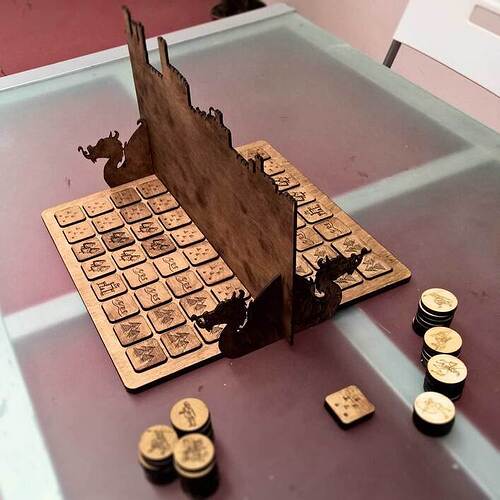Saw this pop up in my feed today. A laser cut version of the game Cyvasse, which apparently is mentioned in two of the Game of Thrones novels. Rules are vague in the book, but fans have generated rules and boards to go with the game. There are various versions, some with a hexagonal board, but this one is pretty darn cool looking. I’m going to have to look into this game some more and see if it sounds good. They say it’s a mix of Stratego, Blitzkrieg (old war game), and Chess. The screen is just there for setup and is taken out for the actual game. They’re charging a pretty penny for it though!
Looks like you would laminate layers of 1/8" wood to make the base and divider, then use some 1/4" for the pieces so they stick out and are easier to handle.
Double sided engrave for sure, fortunately that will be easy on a Glowforge.
This version is far more portable, but for looks I prefer the 3D Printed approach.
The artwork they used looks pretty much like stock artwork. I figured BoardgameGeeks would have a print and play version with artwork, but no luck. Rules are readily available though, as well as some rudimentary artwork
Yeah, the artwork here does seem pretty generic. I do like that 3D printed version too. Maybe I’ll go the more 3D route when I get around to making this (after Catan of course!), and make the figures be standees.
Saw this in my feed from Geek and Sundry today— but thought I’d search to see if already had been posted for inspiration.
I think a non-double-sided engrave on the divider is an aesthetic oversight I would try to remedy were I to make something along these lines.
But my question is this? Can engraving with a laser be precise/uniform in depth enough that you can create the bottom board by just using something like 3/8" or 1/2" and then just engrave out partial depth for the pieces to lay into? I think this would be more attractive than bonding a cut grid in 1/8" atop a solid 1/8". Any thoughts?
So far as we’ve heard this “might” be possible with proofgrade. But with non-proofgrade wood, there is no guaranteeing what is going on under the surface. The laser will remain on one power and speed setting throughout, so as it hits denser/softer material, the engrave will vary depths. This will be especially prevalent when you hit something like a knot in the wood which is super-dense compared to the surrounding material.
However, the GF is supposed to be able to tell how thick an object is via the camera. As such, it “should” be able to tell how deep a recent engrave is, then, ideally it could take multiple passes to flatten out the areas that didn’t go to the proper depth in the initial engrave.
That would be amazing tech, but I would be extremely surprised if the wide angle lens used in the glowforge could detect the depth of an engrave and autocorrect for wood density. I am also equally as sure that the difference in depth wouldn’t be noticed with the human eye in almost all occasions. All speculation but wide angle cameras are crap at showing relative distance
It’s advertised as being able to know material thickness, and determine if there are curved surfaces (i.e. engraving on a Macbook). How out of proportion those claims are or how far down in the hopper they are is still up in the air of course. I don’t imagine it would be able to detect density, but if it was set to engrave 1 mm and after one pass the engraved section was only .5mm, then it would know to run a second pass. If it was .75 mm, then it would know to decrease the power and run another pass. As you say, it remains to be seen to what precision the camera can detect depth like that.
The difference in depth might not be noticeable to the eye, but a flat playing piece sitting in an engraved slot that isn’t flat would certainly feel wobbly. Whether we can accept that is the question. Most of the time I’m sure we could unless this was a dexterity game of stacking pieces!
Fingers crossed you are correct, I would love that as a feature.
The wide angle lens isn’t what determines depth on the Glowforge. It’s the macro camera plus a secondary laser on the head. It should be a really accurate way to measure depth.
Thanks for the knowledge bomb, I remember reading that now. Kind of like getting a bonus feature for me since I had forgotten about it lol

